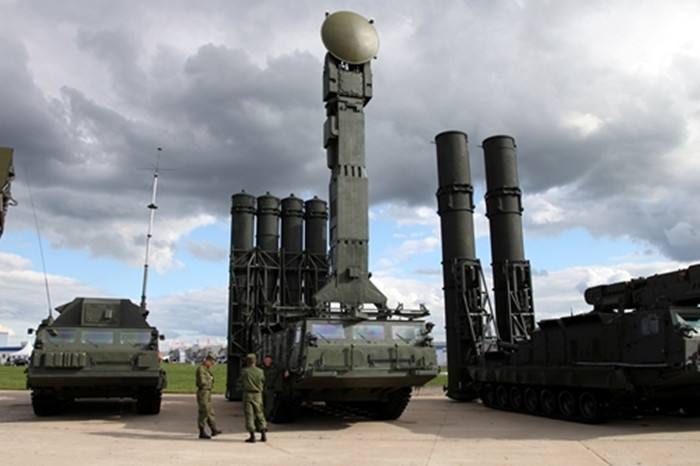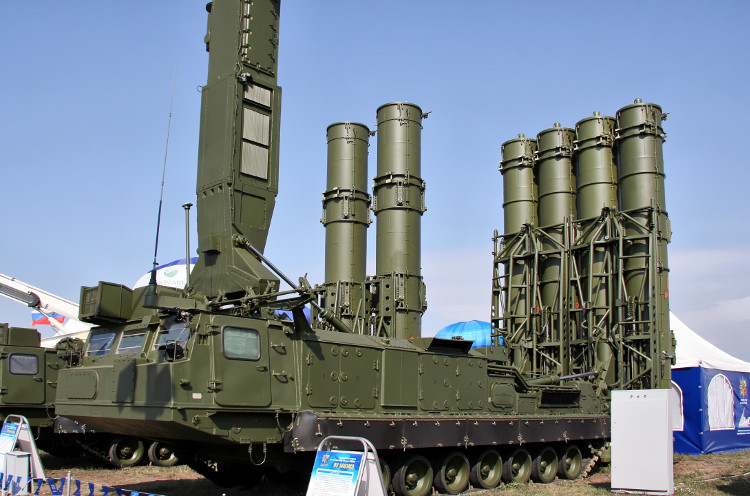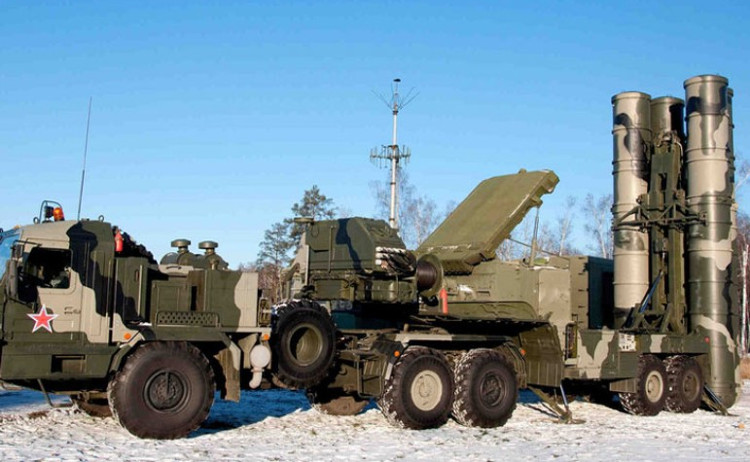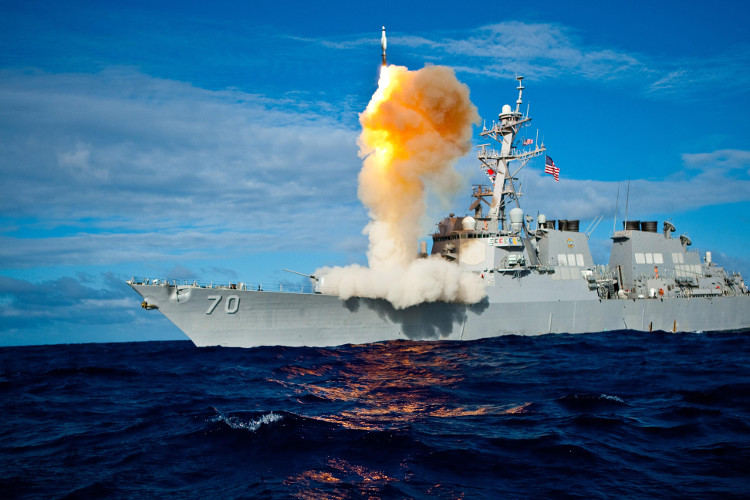The best missile defense systems in the world
The absence of an effective missile defense system will cause nations to be attacked by massive destructive missiles, stealth aircraft and unmanned aircraft.
Here are the best missile defense systems in the world today:
Russian S-300 air defense missile system
S-300 is long-range missile defense systems manufactured by Russia's Almaz Weapons Industry Group, based on the first S-300P version. The S-300 system was developed for the Soviet Air Defense Force to intercept enemy aircraft and cruise missiles. Each new S-300 version has its own preeminent features.

S-300V is the third-floor air defense system of the Russian army, against ballistic missiles, cruise missiles and tactical aircraft.
The S-300V was created from the same S-300 project but was built by Antey Group, also known as Antey-300 . S-300V is the third-floor air defense system of the Russian army, against ballistic missiles, cruise missiles and tactical aircraft. This defense system uses Gladiator missiles with a maximum effective range of 75km and Giant missiles that can hit targets 100km away and at an altitude of about 32km. The S-300V is mounted on MT-T crawler vehicles, making it more maneuverable. S-300V is also slightly different from S-300P. Although both have targeted radars, the S-300V has the ability to automatically search for targets.
It also has a separate ABM radar - 9S19 HIGH SCREEN network radar . A conventional S-300V unit consists of a target surveillance device and designation device, a guided radar and up to six vehicles carrying launchers and radars. S-300V can launch nuclear warheads to destroy targets.

The S-300VM is an upgraded version of the S-300V, also known as the Antey-2500.
The S-300VM is an upgraded version of the S-300V, also known as the Antey-2500. This is Russia's new ballistic missile system. It is designed to destroy targets that are medium and short range ballistic missiles, cruise missiles and missiles launched from space, tactical and strategic aircraft as well as precision control weapons. The new S-300VM uses 9M82M and 9M83M missiles with long range, flexible maneuverability. With a comprehensive observation radar station, the S-300VM is capable of effectively destroying high-speed ballistic missiles and small-scale ballistic killings.
S-300VM interceptor missiles are controlled throughout the entire orbit. Operational payroll of S-300VM missile complex includes: 9S457M command headquarters; wide observation radar station 9S15M2; Observation radar station programmed Ginger 9S19M2 to detect ballistic missiles; SRAM ballistic ballistic missiles and interfering patrol aircraft within 100km; 9S32M multi-frequency missile guidance station; Two 9A83M launchers with 4 9M83M and 9A83M non-controlled anti-aircraft missiles carry 2 9M82M non-control room missiles and means of technical and maintenance.

The S-300PMU-1 missile system is capable of combating short-range ballistic missiles and mid-range tactical ballistic missiles.
S-300PMU-1 was introduced in 1999. In addition to the 5V55R, 48N6E and 48N6E2 missiles, S-300PMU-1 can use two new types of missiles, the 9M96E1 and 9M96E2 (smaller than the previous missiles, at 330 and 420 kg, carrying small 24 kg warheads. The 9M96E1 has a 40 km combat range and 9M96E2 is 120 km. Due to its smaller size, each launcher can carry up to 16 missiles using the 9M96E1 or 9M96E2. The S-300PMU-1 often uses the 83M6E command and control system, although it is also compatible with the old Baikal-1E and Senezh-M1E CCS command and control systems. The 83M6E system is integrated with the 64N6E (BIG BIRD) surveillance / detection radar. The fire / explosion and guidance control radar is 30N6E, which can be combined with a low-range 76N6 surveillance radar and a 96L6E high-altitude surveillance radar. The upgraded version of the S-300PMU - 1 is the S-300PMU - 2 with an expanded range of up to 195 km with the use of the new 48N6E2 rocket. This missile system is capable of not only fighting short-range ballistic missiles but also mid-range tactical ballistic missiles.
American high-level missile defense system THAAD
The final high-altitude missile defense system (THAAD) was built by the US military to shoot down short and medium range ballistic missiles. This project is implemented in cooperation with Raytheon, Boeing, Aerojet, Rocketdyne, Honeywell, BAE Systems, MiltonCAT and Lockheed Martin as the main contractor. After a long period of testing, in 2008, THAAD officially went into service in the US military.

THAAD destroys the target according to the "chase - kill" approach.
THAAD destroys the target according to the "pursuit - kill" approach , meaning that the interceptors don't carry nuclear warheads and destroy the target through impulse and kinetic energy. In the period of approaching enemy missiles, THAAD uses interceptor modules equipped with self-guided infrared warheads to track targets. The missile destroys the target by kinetic energy from a high-speed collision, not using warheads that contain explosives like normal missiles.
Each battery of THAAD consists of 4 missile launchers (8 launchers / vehicles), AN / TPY target and fire control radar - 2 with a mobile control center and 2 operation centers TOC tactics ("heart" of each center is the Hewlett - Packard HP - 735 data processing system). In particular, AN / TPY - 2 is a phase radar network operating in the X band, capable of detecting threats from short-range, mid-range ballistic missiles at a distance of 1,000km. When fighting, AN / TPY - 2 "god eyes" will perform the task of finding and detecting targets (threats from tactical ballistic missiles, medium range ballistic missiles). It can also receive target parameters from other ballistic missile defense radar systems. After that, the battle data system will calculate the target parameters and activate the interceptor missile. This missile has the ability to intercept target at a range of 150 - 200km, a height of 25km.
THAAD has undergone many trials and successes but also many failures. However, this is still one of the world's most modern mid-range ballistic missile and tactical ballistic interceptor systems. They set up a "shield" for the US and its allies from the threat of enemy ballistic missiles.
S-400 missile defense system
The S-400 is a new generation missile defense system designed to replace S-200, S-300V, S-300PMU1 and S-300PMU2. Introduced in 1999, the S-400 immediately became the main weapon guarding Russia's sky with unique features in the world, compatible with four different types of missiles.

The S-400 is Russia's main anti-aircraft weapon, with a "unique" feature in the world.
S-400 has the ability to shoot down all aerial targets, such as strategic aircraft, tactics, reconnaissance ., intercepting medium-range, tactical ballistic missiles . from a distance of 400km, 30km height and maximum target speed of up to 4,800 m / sec. Notably, the S-400 can intercept strategic missiles with a range of 3,500km, 3.5 times more than the US Patriot missiles.
The standard structure of S-400 long range mobile air defense missile system includes 30K6E control combination, 98Z6E missile, 48H6E / 48H6E3 rocket and 30S6E technical guarantee combination. All are arranged on wheeled vehicles that can move easily, maneuverably, have power supply systems, communication, orientation and ensure independent living. In order to increase the combat capability within a radius of 100 km and the terrain is divided, the S-400 is equipped with data transmission and communication transmitters, with the 40V6M tower to enhance the versatile radar antenna array 92N6E.
In addition, the S-400 outperforms some of the modern air defense missile systems in the world in terms of the ability to detect targets at a maximum distance of 600km. At the same time, the S-400 can track 300 targets, shoot down 32 targets simultaneously and guide 72 missiles.
The S-400 is capable of destroying targets that fly only 10 meters from the ground to the highest 27km. The target of the guided missile will be shot down within 2 - 27km. Time to deploy the complex only takes 5 minutes, the shortest compared to other systems of the same function in the world.
The S-400 is considered the "trump card" of the Russian defense system for at least the next few decades.
Russian S-500 missile defense system
The S-500 missile defense system is a high quality version of the S-400 system . The S-500 is capable of simultaneously intercepting 10 mid-range ballistic missiles with a range of 3500 km. Particularly for altitude and interception speed, the S-500 tops the world.
The S-500 is capable of shooting down high flying targets up to 200km, at a speed of 7km / s. In addition, the S-500 also has the ability to intercept all types of medium-range ballistic missiles, short-range campaign, tactical, supersonic cruise missiles.
The combat deployment time of the S-500 system takes only 3-4 seconds to fire another target. The S-500 radar radar and fire control radar system is built on the core of the X-Band active phase array radar, with coverage and scouring reaching 800-1,000km.
With its superior long-range, high-range ballistic interceptor, the S-500 has overshadowed all three anti-Patriot-3 missile defense and missile systems, name defense systems The latest fire is THAAD and the Aegis missile defense system (including SM-3 and SM-2). These three systems are the 3-storey, low, medium and high-range missile defense for the US.
American Patriot anti-ballistic missile system
Patriot Advanced Capability ballistic missile missile system, referred to as Patriot (PAC) , was developed by the US to replace the Nike Hercules system (the Pentagon's mid-range and high-range air defense system) and replace MIM-23 Hawk system (mid-range tactical air defense system of the US military). The Patriot uses an advanced high-performance aerial missile and radar system. Patriot was built in the Arsenal Redstone in Huntsville, Alabama, where previously developed the ABM defense and Spartan and Sprint missiles within the Patriot system.

Patriot uses an advanced interceptor and radar missile system.
When arriving at the combat position, the tractor truck will be separated from the vehicle carrying the missile, the missile launcher will be fixed by the hydraulic support legs. Patriot uses the target search radar and AN / MPQ-53/65 integrated fire control. This is a passive electronically scanned network radar. The radar antenna array can transmit up to 5,000 beams per second, in addition to the IFF "you-crack" identification system with a sub-system to reduce the impact of interference measures on radar operation.
AN / MPQ-53/65 is a unique radar designed according to the "detection - pursuit" technology . The radar can control 100 targets within 170 km and can control 9 missiles simultaneously. This integrated radar design has the advantage of reducing the need for more general control systems, reducing system bloat.
Patriot has a complex and sophisticated navigation mechanism, the first phase of the missile is guided by inertia, the period between missiles is guided by the mechanism of TVM (follow-up of bullets), the last phase of missiles is used Active radar to lock targets. Patriot range from 30 - 160km depending on the variant.
The United States sold some Patriot defense systems to allies like Egypt, Germany, Israel, Japan, the United Arab Emirates .
US Aegis ballistic interceptor system
The Aegis ballistic missile interceptor system (ACS) is a naval weapon system deployed on the sea, developed by US Rocket and Ground Radar, now produced by Lockheed Martin Group. Aegis was designed to destroy mid-range and long-range ballistic missiles with SM-3 interceptors, and intercept short-range missiles with SM-2 interceptors.

The Aegis ballistic missile system (ACS) is a naval weapon system deployed on the sea.
In the US Navy service, the Aegis combat system was equipped on the Ticonderoga class cruisers and Arleigh Burke class destroyers. More than 100 warships equipped with the Aegis interceptor system deployed to the navies of allied nations are South Korea, Japan, Norway and Spain. The Australian Navy also selected this system to equip its new destroyers.
ACS control system (AWS) - "heart" - includes AN / SPY-1 radar, MK 99 fire control system, standard missile system SM-2 . ACS controlled by one The 3-way multi-function electronic radar automatically detects and directs, it can track more than 100 targets simultaneously at 190km away.
- Missile defense system for passenger aircraft
- Missile shield in aircraft belly
- Surface of the missile 'blows' the world's strongest warship
- Discover the Minuteman III rocket engraved by the fire dragon S-400
- America failed to try to intercept missiles from aircraft
- Israel test missile defense
- Missile Laser - Solution for air defense
- Video: US missile defense system shows China must be
- Visit rocket manufacturing factory for S-300 Vietnam
- The power of the THAAD missile defense system
- Video: The terrifying power of the S-400 missile combination
- R-73, Russia's No. 1 air-to-air missile
 'Fine laughs' - Scary and painful torture in ancient times
'Fine laughs' - Scary and painful torture in ancient times The sequence of numbers 142857 of the Egyptian pyramids is known as the strangest number in the world - Why?
The sequence of numbers 142857 of the Egyptian pyramids is known as the strangest number in the world - Why? History of the iron
History of the iron What is alum?
What is alum?